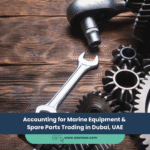Accounting for Setting Up a Foreign Subsidiary and Consolidating its Financials
For ambitious UAE-based companies, expanding into international markets by setting up a foreign subsidiary is a powerful growth strategy. It opens up new revenue streams, diversifies risk, and builds a global brand. However, this strategic leap introduces significant accounting complexities. The process is governed by stringent International Financial Reporting Standards (IFRS), particularly IFRS 10 for consolidation and IAS 21 for foreign currency effects.
- Accounting for Setting Up a Foreign Subsidiary and Consolidating its Financials
- Step 1: The Setup and Initial Investment
- Step 2: The Currency Translation Process (IAS 21)
- Step 3: The Consolidation Process (IFRS 10)
- What Excellence Accounting Services (EAS) Can Offer
- Frequently Asked Questions (FAQs)
- Go Global with Confidence.
Accounting for a foreign subsidiary is a multi-layered challenge. It involves translating the subsidiary’s entire set of financial statements from its local currency into the parent company’s currency (e.g., AED), meticulously eliminating intercompany transactions, and then combining the two entities’ financials as if they were a single economic entity. Errors in this process can lead to misstated financial reports, poor management decisions, and non-compliance with tax and regulatory bodies.
This guide provides a clear roadmap for UAE parent companies on how to account for a foreign subsidiary, from the initial investment to the final consolidated financial statements. We will demystify the currency translation process, explain the key steps of consolidation, and clarify the crucial UAE Corporate Tax implications of earning foreign income.
Key Takeaways
- Follow IFRS 10 & IAS 21: These are the guiding standards for consolidating financials and handling foreign currency translation. Compliance is mandatory for IFRS reporters.
- Currency Translation is Key: A subsidiary’s financials must be translated from their “functional currency” to the parent’s “presentation currency” using specific exchange rates for different financial statement items.
- Translation Differences go to OCI: The net difference arising from the currency translation process is not recorded in the profit and loss statement but in “Other Comprehensive Income” (OCI) as a Foreign Currency Translation Reserve (FCTR).
- Eliminate Intercompany Transactions: All transactions and balances between the parent and subsidiary (e.g., sales, loans, receivables) must be fully eliminated upon consolidation.
- UAE Participation Exemption: The UAE Corporate Tax law offers a participation exemption, potentially making dividends and capital gains from a foreign subsidiary tax-free, provided certain conditions are met.
Step 1: The Setup and Initial Investment
The journey begins with the legal and financial establishment of the subsidiary. This may involve acquiring an existing company or incorporating a new one. The parent company’s initial investment (e.g., cash transferred to capitalize the new entity) is recorded as an asset on its individual balance sheet.
Parent Company’s Books:
Debit: Investment in Subsidiary [Amount]
Credit: Cash/Bank [Amount]Expert advice on company formation and due diligence is critical at this stage to ensure the legal and financial structure is sound.
Step 2: The Currency Translation Process (IAS 21)
Before you can combine the financials, you must translate the subsidiary’s statements into the parent’s currency. IAS 21 dictates the rules. First, you must determine the subsidiary’s **functional currency**—the currency of the primary economic environment in which it operates (e.g., EUR for a German subsidiary). This is then translated to the parent’s **presentation currency** (e.g., AED).
The Translation Rules:
| Financial Statement Item | Exchange Rate to Use |
|---|---|
| Assets & Liabilities (e.g., Cash, Inventory, Payables) | Closing Rate (the spot rate at the balance sheet date). |
| Income & Expenses (e.g., Revenue, Salaries, Rent) | Transaction Date Rate or an appropriate Average Rate for the period. |
| Equity (e.g., Share Capital, Retained Earnings) | Historical Rate (the rate on the date of the original transaction). |
| Resulting Imbalance | Recorded in Other Comprehensive Income (OCI) as the Foreign Currency Translation Reserve (FCTR). |
The FCTR arises because different rates are used for different items, creating an imbalance. This reserve accumulates on the consolidated balance sheet within equity.
Step 3: The Consolidation Process (IFRS 10)
Once the subsidiary’s financials are translated into the parent’s currency, the consolidation can begin. The goal of IFRS 10 is to present the parent and its subsidiary as a single economic entity.
Key Consolidation Adjustments:
- Combine Line by Line: Add together the assets, liabilities, equity, income, and expenses of the parent and the translated subsidiary.
- Eliminate Parent’s Investment: The parent’s “Investment in Subsidiary” asset is eliminated against the subsidiary’s equity (share capital and pre-acquisition retained earnings).
- Recognize Goodwill: If the purchase price was higher than the fair value of the subsidiary’s net assets, the difference is recognized as Goodwill, an intangible asset. A professional business valuation is crucial here.
- Eliminate Intercompany Balances: Any receivables/payables between the two companies (e.g., an intercompany loan) must be removed.
- Eliminate Intercompany Transactions: The effects of transactions between the companies, such as sales of inventory, must be eliminated to avoid recognizing unrealized profit.
This process requires meticulous accounting and bookkeeping to ensure every intercompany element is identified and correctly removed.
What Excellence Accounting Services (EAS) Can Offer
Global expansion is complex. EAS provides the specialized financial expertise to ensure your international operations are built on a solid, compliant foundation.
- Strategic CFO Services: Our CFO services provide high-level guidance on structuring your international expansion, managing foreign currency risk, and optimizing your global financial strategy.
- Consolidated Financial Reporting: We manage the entire consolidation process, from currency translation under IAS 21 to the preparation of IFRS 10 compliant consolidated financial statements, delivering accurate financial reports for management and stakeholders.
- Corporate Tax Advisory: Our tax experts ensure you meet the conditions for the UAE’s participation exemption, structure intercompany transactions efficiently, and comply with all corporate tax regulations on foreign income.
- Company Formation & Due Diligence: We assist with the crucial first steps, whether it’s establishing a new entity or conducting thorough due diligence on an acquisition target.
Frequently Asked Questions (FAQs)
Translation is used when the subsidiary’s local currency is its functional currency. Remeasurement is a more complex process used when a subsidiary’s records are not kept in its functional currency (e.g., a German subsidiary with a functional currency of EUR keeps its books in USD for convenience). Remeasurement differences go directly to the Profit & Loss statement, not OCI.
Upon disposal of the foreign subsidiary, the cumulative FCTR balance that is sitting in Other Comprehensive Income is “recycled.” This means it is reclassified from equity to the Profit & Loss statement, where it will form part of the gain or loss on the sale of the subsidiary.
This creates foreign exchange gains/losses on both the parent’s and subsidiary’s books, which must be calculated each reporting period. Upon consolidation, the principal amount of the loan is eliminated, but the net foreign exchange gain/loss may not fully cancel out and can require a complex consolidation adjustment.
Goodwill is recorded in the functional currency of the foreign subsidiary. Each year, at the reporting date, it must be translated into the parent’s presentation currency using the closing exchange rate, just like any other asset. It is not amortized but must be tested for impairment annually.
If the parent company owns less than 100% of the subsidiary (e.g., 80%), the remaining 20% is the NCI. In consolidation, you still combine 100% of the subsidiary’s assets and liabilities. However, you must show the NCI’s share of the subsidiary’s net assets and profit separately in the consolidated financial statements.
Not necessarily. The subsidiary must comply with its own country’s local accounting standards (Local GAAP) for its statutory filings. However, for consolidation purposes, its financial data must be adjusted to be IFRS-compliant before it is translated and consolidated by the UAE parent company.
If a subsidiary operates in a hyperinflationary economy (as defined by IAS 29), a different set of rules applies. Its financial statements must first be restated for the effects of inflation before being translated into the parent’s presentation currency using the closing rate for all items, including the income statement.
According to guidance from the FTA, key conditions typically include the UAE parent holding at least 5% of the subsidiary’s shares for an uninterrupted period of 12 months, and the subsidiary being subject to a corporate tax rate of at least 9% in its home country. The rules are specific, so professional tax advice is essential.
An average rate should be a reasonable approximation of the rates on the dates transactions occurred. For a stable currency, a simple average of the opening and closing rates might suffice. For a volatile currency, a weighted average based on the timing of revenues or a monthly/quarterly average might be more appropriate to avoid distortion.
The biggest challenges are often operational: obtaining accurate and timely data from the subsidiary, aligning different accounting policies, managing complex intercompany reconciliations, and dealing with different software systems. Strong communication and standardized reporting templates are key to overcoming these hurdles.
Conclusion: A Framework for Global Growth
Expanding overseas is a testament to a company’s success, but it marks a new chapter in financial complexity. A disciplined approach to accounting for foreign subsidiaries, grounded in the principles of IFRS 10 and IAS 21, is not just a compliance exercise—it’s a strategic necessity.
By mastering currency translation, intercompany eliminations, and consolidation, UAE businesses can ensure their global financial reporting is accurate, transparent, and provides a true and fair view of their international enterprise. This builds trust with investors, lenders, and regulators, creating a solid financial backbone for sustained global growth.
Go Global with Confidence.
Let Excellence Accounting Services manage the intricacies of foreign subsidiary accounting, so you can focus on driving your global business strategy.




